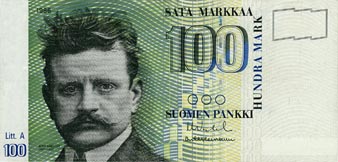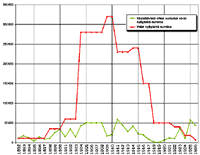
The diagram below shows Jean Sibelius's finances. The estimates for each year include salaries, pensions, grants, fees, inheritances, gifts and payments from publishers. The debts include both long-term debts and payments he is known to have owed.

Click on the diagram to enlarge it
As a scholarship student, Sibelius began to get into debt when he married and set up house. In the 1890s he worked as a poorly paid teacher and occasionally received money for his concerts. His works had not yet been published abroad, and he was only able to conduct his music in Finland. Despite his small income Sibelius wished to live in accordance with what he regarded as his station, and the family often had a full-time servant. In 1898 his debts amounted to 35,000 euros.
Sibelius's income grew rapidly when he began to receive his artist's pension, starting from 1898. At the same time he established contacts with the publishing house of Breitkopf & Härtel. After the early 1900s Sibelius became sufficiently famous to be able to conduct his music abroad, but the construction of Ainola increased his burden of debt, which amounted to 280,000 euros in 1904. The risks he took would eventually have a successful outcome, but Sibelius could not know that. At this point he had to support his family through short-term borrowing, as the banks would no longer grant him long-term loans.
A publishing contract with Robert Lienau during the years 1905-1909 was profitable, but it forced Sibelius to work quickly: he had to write four major orchestral works a year. With the help of his pension, his fees for concerts and the payments from the publisher his annual income probably amounted to 50,000 euros. However, the construction of the sauna at Ainola, his luxurious way of life and his employment of servants (both household servants and a man for general work) ate into his income. His debts peaked at the equivalent of 320,000 euros. Sibelius would probably have gone bankrupt if Axel Carpelan and other patrons had not taken action and paid off some of his bills in 1910. The long-term loans remained: in 1911 his debts still amounted to 230,000 euros.
In these days Sibelius led a sober life and stayed away from restaurants. At least his indebtedness did not increase, and after the performances in the United States in 1914 the composer was optimistic: a tour in the United States envisaged for the following year would solve his debt problems.
The outbreak of the First World War shattered his dreams. His German publisher soon got into trouble, and Sibelius's income collapsed. After the composer's 50th birthday festivities only a new nationwide collection kept the bailiffs away from his door. His debt was still 150,000 euros.
The turmoil of the First World War, and especially the Civil War in 1918, led to inflation. This ate into Sibelius's income - but also into his debts. In 1918 the debt stood at 50,000 euros.
Sibelius's pension was readjusted after the war. Moreover, as the horrors of war were receded, he was able to conduct his works abroad. From now on the flow of money from publishers increased. Although Sibelius occasionally lived quite luxuriously, his burden of debt did not increase during the early 1920s. In addition, the royalties he received from Europe soon became an important source of income.
The many donations given at the time of his 60th birthday solved his debt problems, and in 1927 Sibelius was free of debt. In the same year the Finnish copyright laws were reformed and Sibelius soon became rich. In fact, he died a very wealthy man. The royalties from his large output will continue to generate considerable income for his descendants until seventy years after his death, i.e. until the year 2027.
Thus Sibelius's spending, which at times seemed irresponsible, eventually turned out to be a successful gamble: by getting into debt he made sure that he and his family could live in comfort. By the age of sixty-two he was completely free of debt, and his income clearly exceeded his expenditure.

